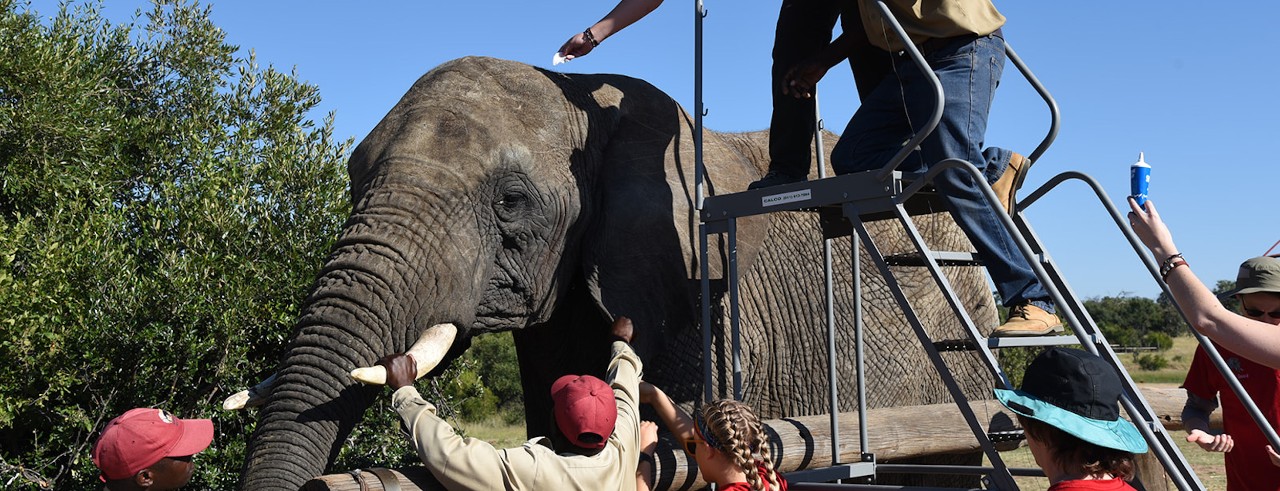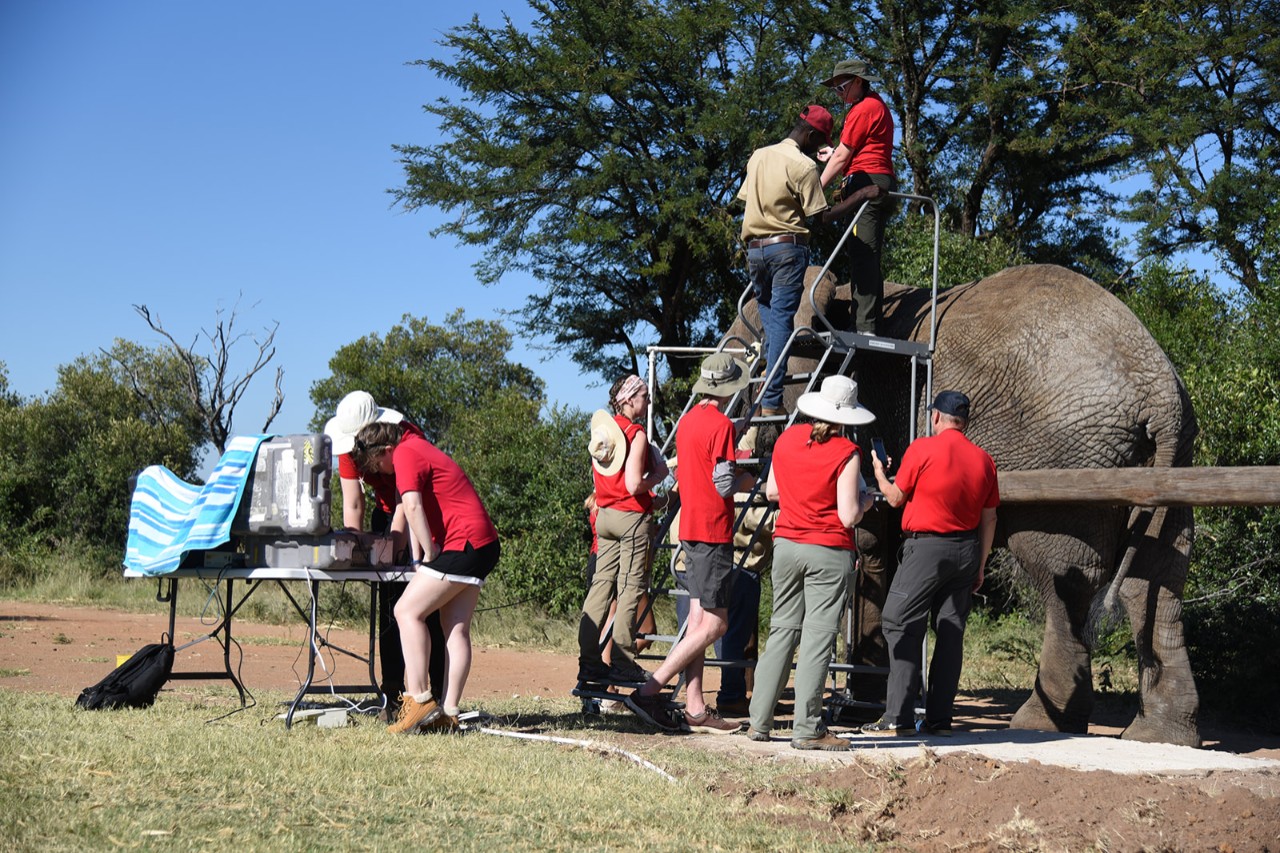
What the herd heard: UC team studies African elephants
UC audiology students conduct first-ever elephant hearing tests during spring break trip
What can elephants hear and do they communicate at frequencies humans can’t? That is what seven students from the University of Cincinnati went to South Africa to find out. Undergraduates in Communication Sciences and Disorders (CSD) in the College of Allied Health Sciences (CAHS) spent their spring break testing the hearing of elephants in Bela-Bela, South Africa. This is the second trip that Pete Scheifele, PhD, professor, and executive director of FETCHLAB at UC, has made to Bela-Bela as part of a project that is the first to ever test the hearing of African elephants.
“Nobody knows the exact frequency range elephants can hear and what is needed to be able to make the elephant hear it, and detect that sound,” says Scheifele. “Some research has been done on elephant communication and we know that elephants make certain kinds of sounds and some of these sounds are seismic, allowing them to communicate with each other through the ground at very far distances.”
Scheifele says in addition to picking up vibrations in their feet, they also pick up some through their trunk and process these vibrations in the auditory portion of their brain. While working with the elephants at the Indianapolis Zoo, he has seen instances where the matriarch of the herd will make a sound that humans can’t hear but can feel in their chest that produces a reaction in the other elephants.
Scheifele and his team have performed hearing testing on elephants in the Indianapolis Zoo, building off his work that originated with puppies at his UC FETCHLAB and other exotic animals under professional care at zoos and aquaria. Scheifele took an exploratory trip to Bela-Bela in the fall of 2018, setting the stage for the 2019 trip. This project is an example of UC’s Innovation Agenda as outlined in its strategic direction Next Lives Here.
“Our job is to find out exactly what an elephant can actually hear and report that,” says Scheifele. “We have electrophysiological equipment, the same technology we use with puppies. We deliver sound to their ear and they have alligator clip electrodes attached producing an EEG reading that displays what they can hear on the screen.”

UC students conduct hearing tests on an elephant in Bela-Bela, South Africa
The research project in Bela-Bela is part of a conservation effort to keep poachers from killing elephants and bringing ivory into other countries illegally, funded in part by the U.S. Army. A few other institutions including Duke University are developing a device that is able to track where the elephants are by measuring the amount of pressure put on the ground when the elephants move.
“They can then take that and use GPS to pinpoint on a map the location of the herd,” says Scheifele. “Knowing where the elephants are provides information on where the poachers are probably going to be, and that information will help to alleviate poaching.”
Scheifele says much of the initial research by his team involves getting used to working with the elephants and having the elephants become comfortable with the testing process. Since this type of research has never been done before, it’s on his team to find out the best places to connect the electrodes, and how to manipulate the elephant’s ears for the hearing tests.
Jeffrey DiGiovanni, PhD, director of the CSD program, went on the trip to Bela-Bela, in part to vet the experience as one that could happen on a recurring basis.
“It’s very difficult to train elephants to respond to sound. Elephants are very different from most animals,” says DiGiovanni. “Most animals hear higher frequencies than we do, like dogs and dolphins for example. Elephants are the opposite. They hear much lower, it’s seismic. They can hear earthquakes. Sometimes they will lift up a leg to triangulate those seismic sounds.”
“Most animals hear higher frequencies than we do, like dogs and dolphins for example. Elephants are the opposite. They hear much lower, it’s seismic. They can hear earthquakes."
Jeffrey DiGiovanni, PhD
The group did its research at Adventures With Elephants (AWE), a conservation reserve about 45 minutes west of Bela-Bela, which offers a variety of hands-on elephant experiences targeted to tourists. The tourist experiences at AWE are done in the afternoons, so Scheifele and his team did their work in the morning.
The elephants were trained to stand by a structure where tourists board the elephants and the research team placed three electrodes on the animal. A speaker was then held up to the elephant’s ear and a test sound was played at a particular frequency. This was done by the AWE trainers in collaboration with the UC FETCHLAB’s exotic animal trainer and animal behaviorist, Lesa Collins Scheifele.
“Right now, we’re testing frequencies that we can hear as humans,” says Scheifele. “The Army Research Office has gotten us a very large subwoofer that can go down to seismic frequencies that people can’t hear. Once we establish the highest frequencies the elephants can hear, we will ship this speaker over and start testing all of the very low frequencies that we’re incapable of hearing.”
Student Jenny Gale describes the experience as a trip of a lifetime.
“To be able to have such close up access to the elephants was an incredible experience and to be able to expand our current research efforts at an amazing facility like AWE was beyond rewarding,” says Gale. “I hope that our research efforts will contribute to a better understanding of elephant hearing so that we can help protect the elephants from poaching and help conserve them.”
It wasn’t all research all the time for the students. During their afternoon free time, they participated in service projects.
“There is a settlement community nearby that was set up by Namibians who were disenfranchised from their country,” says DiGiovanni. “We got connected with them and did some community service projects with them, repairing, patching and epoxying floors for their school. That gave students a little bit of a service learning aspect as well.”
Student Hannah Wilson says it was eye-opening to be immersed in South African culture and to have so many opportunities to learn about the people there, as well as the elephants.
“I have always loved elephants, so getting to work up close and personal with them was a once in a lifetime experience,” says Wilson. “We gained valuable information for our research, which is part of my capstone project.”
The current plan is to take another group of students on a research trip to Bela-Bela this fall, and then go there two or three times in 2020 as they test different frequencies on the elephants.
“As budding audiologists, this is an experience they’re probably never going to get again in their lifetime,” says Scheifele. “Just to be there and say we’re actually doing research with two or three ton animals is a major thing. It’s not like working on infants or people. It’s a whole different world.”
Featured image at the top: UC audiology students conduct hearing tests on an African elephant in Bela-Bela, South Africa. Photo credit: Jeffrey DiGiovanni, College of Allied Health Sciences.
Additional Contacts
Related Stories
NEXT Innovation Scholar Charlie Harker
April 21, 2025
From strategizing with community leaders on the future of transportation solutions to collaborating with global corporate partners to dive into complex consumer insights, the NEXT Innovation Scholars (NIS) program at the University of Cincinnati empowers a new generation of leaders and problem solvers.
Tech pioneers predict future breakthroughs in AI and quantum...
April 17, 2025
The CEOs of IBM, Qualcomm and responsible AI nonprofit Humane Intelligence spoke at South by Southwest on the future of AI and quantum computing. We’ll unpack their insights.
UC, GE Aerospace Foundation celebrate Next Engineers grads
April 15, 2025
The University of Cincinnati played host in April to the graduation of this year’s class of the GE Aerospace Foundation’s Next Engineers, a global college- and career-readiness program that provides scholarship incentives for young people to become engineers.
